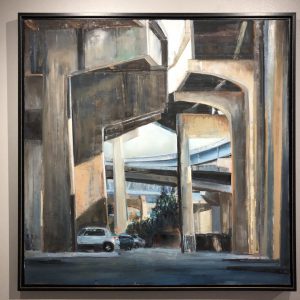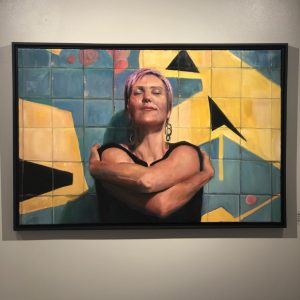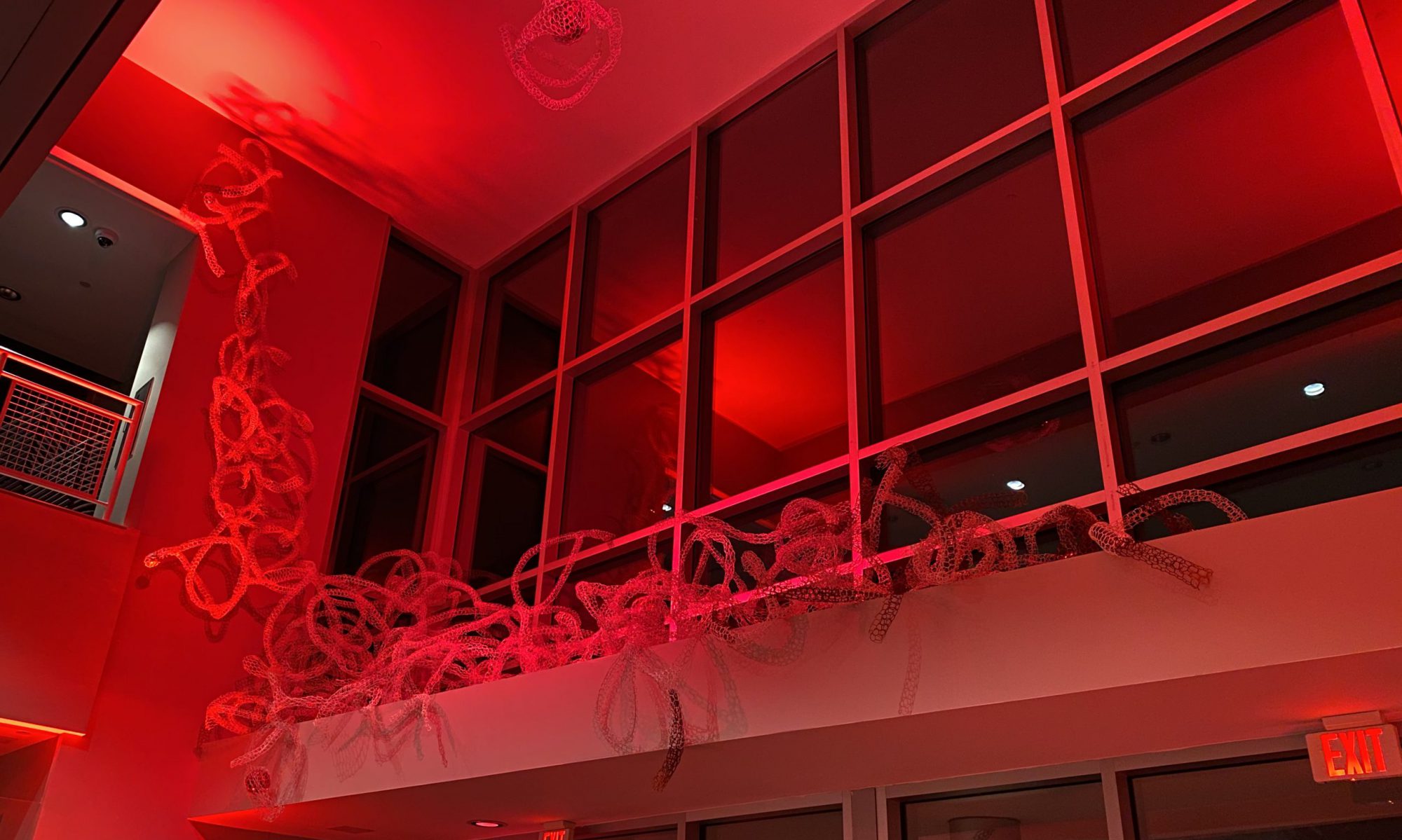A Conversation with Cathy Abramson
“Dreams of the Underground”
On display in the Margaret W. & Joseph L. Fisher Art Gallery through December 23rd, 2019
Rachel M. Schlesinger Concert Hall and Arts Center
Can you describe your artistic process?
 I start by taking photos, lots of photos. I try to carry my camera or iPhone with me and will stop and take a picture if something strikes me as noteworthy, a building in the golden hour, a shadow, people gathered at a public event, a reflection in a window. Often the images won’t make a full composition but have an interesting texture of an element that could be part of a painting. I spend a lot of time thinking about the images I’ve gathered and something will call out to me and then I’ll start composing an image in Photoshop. Frequently this image becomes a small painted color study and if the potential is there for a larger painting, I’ll go ahead and will begin sketching the image in paint on a toned canvas or panel. First I work up a value study and when I’m pleased with the result I add color. I often use squeegees and rollers in addition to my paint brushes to get a desired effect.
I start by taking photos, lots of photos. I try to carry my camera or iPhone with me and will stop and take a picture if something strikes me as noteworthy, a building in the golden hour, a shadow, people gathered at a public event, a reflection in a window. Often the images won’t make a full composition but have an interesting texture of an element that could be part of a painting. I spend a lot of time thinking about the images I’ve gathered and something will call out to me and then I’ll start composing an image in Photoshop. Frequently this image becomes a small painted color study and if the potential is there for a larger painting, I’ll go ahead and will begin sketching the image in paint on a toned canvas or panel. First I work up a value study and when I’m pleased with the result I add color. I often use squeegees and rollers in addition to my paint brushes to get a desired effect.
When did you know that you were in an artist?
I always loved to draw. I never got good grades in art courses but it was just something I loved doing. I needed a job and took illustration and graphic design courses and became an illustrator and art director even though my first degree was in Political Science. One of my first jobs was as an art director at a political magazine and I drew a pretty good Ronald Reagan. One letter to the editor commented on a cartoon I did for the magazine. It said that one of my cartoons was offensive...I knew I was off and running!
When I retired as an art director, I was able to take a 3 year course of master painting techniques at the Compass Atelier in Rockville, get a studio and paint as much as I could. I can now spend a good amount of my time painting.
What are your artistic inspirations? Are there particular artists or art movements that are an inspiration to you?
I’m a representational painter and like the structure of painting something recognizable. I’ve always loved Edward Hopper and my work is often compared to his although I think my paintings are not as lonely and the characters are not as isolated. I’ve always been interested in narrative and looked to illustrators for inspiration. I’ve spent many hours looking at the art of Ben Shahn, Edward Sorel, Ralph Steadman, David Levine, Leonard Baskin and copying their work. As far as painters are concerned, aside from Hopper, there are any number of contemporary painters that I admire: Burton Silverman, Alyssa Monks, Steven Assael, Lucien Freud, any of the California figurative painters.
More recently I’ve been following Alex Kanevsky and David Kassan. Often the last show or artist I’ve seen becomes my new favorite.
Why does the urban environment inspire you over other environments?
I love the activity, interplay of light and shadow, and the sheer mass of architectural forms. Everything is constantly changing in the urban environment and there’s an urgency to really look and see what’s going on. There’s also a need to examine the underlying politics and social interactions and decode what is apparent and what lies just below the surface.
What is it that you hope to capture of your experience in Washington DC and other locations?
Many of my past paintings in the district had to do with neighborhoods and people in transition. Many neighborhoods including the Kennedy Street corridor are being overhauled and there are stories to record and examine. Now I’m interested in the Brutalist buildings in Washington, DC. There’s a gritty beauty in parking garages or the many government buildings that are wall-to-wall slabs of concrete. Believe it or not, even the FBI building has a certain charm. I like to see how people interact with these sterile buildings and think of a narrative for those settings and people.
You have a painting in the exhibition entitled “Cathedral”. What about the subject matter inspired you to call the painting after a type of church?

“Cathedral” is an underpass at the beginning of Magazine Street in New Orleans, near the National WWII Museum. I’ve done a number of paintings at this location and there’s the potential for many more. I loved how the light filtered in between the massive highway supports, much like the light filtering through stained glass windows and falling on the columns in a cathedral.
The texture of the concrete and metal are similar to textures found in cathedrals. The parked cars add a human scale to the setting much like the congregants who are dwarfed by the soaring ceilings in a cathedral. The final note is that cars and technology are worshiped in America.
Tell us about the people in your paintings? For example the women that is the subject of “ In her Shadow” or “ Dream of the Underground”
 The woman in “In Her Shadow” is Ms. Vee, Veronica Cooper. She is a force of nature and began her career as one of the first female pullman porters, She has worked as an accountant, seamstress and artist. She owned and operated Culture Coffee on Kennedy Street and opened Culture Coffee Too in Fort Totten a couple of years ago. She is always stylish from her brightly colored glasses to her gold lame pants.
The woman in “In Her Shadow” is Ms. Vee, Veronica Cooper. She is a force of nature and began her career as one of the first female pullman porters, She has worked as an accountant, seamstress and artist. She owned and operated Culture Coffee on Kennedy Street and opened Culture Coffee Too in Fort Totten a couple of years ago. She is always stylish from her brightly colored glasses to her gold lame pants.

I don’t know much about Sara, the model and dancer in “Dreams of the Underground.” Sara Lavan is the Founder, Executive and Co-Artistic Director of local motion project and was a model the day of a photo shoot and fundraiser that I attended I loved the way she hugged herself and seemed to be wrapped in her own world and dreams. And, what’s not to love about her pink hair.
What is that you would like the viewer to take away from their experience of seeing this exhibition?
I’d like people to come away with a new appreciation for our urban environment, it’s stories and it’s people. Living in a city is a moment to moment experience and I try to isolate a moment, capture it, and move on. These fleeting moments often resonate with the viewer’s own life and narratives. I love to hear the stories the viewers invent on the spot!
Is there any advice that you would give students who have made the decision to pursue art?
It’s very simple, if you love it, do it. Making a living as an artist can be a stretch but you can find a little time here and there for your art. Scale your projects to the time you have available so you don’t get frustrated. If art is important to you make it a priority and expect others to respect your time. Try to schedule time for art just as you schedule time for work, family, friends and all your other interests. Making art can be a joyful, sensual experience and making good art is probably one of the most difficult things you can attempt. The sense of accomplishment you get when you produce something you are proud of is unbeatable.
What can we expect from your work in the future?
I have so many projects and paintings in mind. My next few paintings will be portraits, some personal and some of the women I met while teaching some art classes at a local women’s shelter. I struggle with portraiture and want to get much better. After that it’s back to paintings of DC. I took a number of photos at last year’s Funk Parade and can’t wait to paint from those amazing, colorful images.

